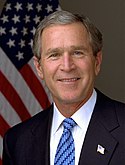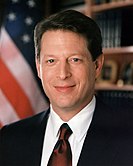United States presidential election in Florida, 2000
|
|
||||||||||||||||||||||||||
|---|---|---|---|---|---|---|---|---|---|---|---|---|---|---|---|---|---|---|---|---|---|---|---|---|---|---|
|
||||||||||||||||||||||||||
|
||||||||||||||||||||||||||

County Results
Gore—60-70%
Gore—50-60%
Gore—40-50%
Bush—40-50%
Bush—50-60%
Bush—60-70%
Bush—70-80%
|
||||||||||||||||||||||||||
|
||||||||||||||||||||||||||
William Jefferson Clinton
Democratic
The 2000 United States presidential election in Florida took place on November 7, 2000, as part of the nationwide presidential election. Florida, a swing state, had a major recount dispute that took center stage in the election. The outcome of the 2000 United States presidential election was not known for more than a month after balloting because of the extended process of counting and recounting Florida's presidential ballots. State results tallied on election night gave 246 electoral votes to Republican nominee Texas Governor George W. Bush and 255 to Democratic nominee Vice President Al Gore, with New Mexico (5), Oregon (7), and Florida (25) too close to call that evening. Gore won New Mexico and Oregon over the following few days, but the result in Florida would have been decisive however those two states had voted.
After an intense recount process and the United States Supreme Court's decision in Bush v. Gore, Bush won Florida’s electoral votes by a margin of only 537 votes out of almost six million cast and as a result became the president-elect. The process was extremely divisive, and led to calls for electoral reform in Florida.
...
Wikipedia


